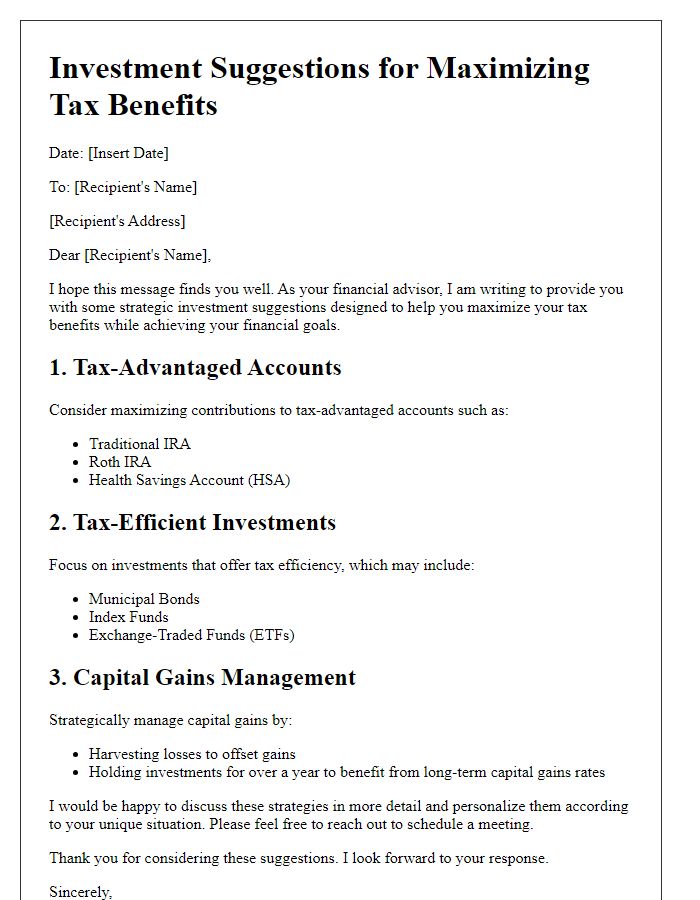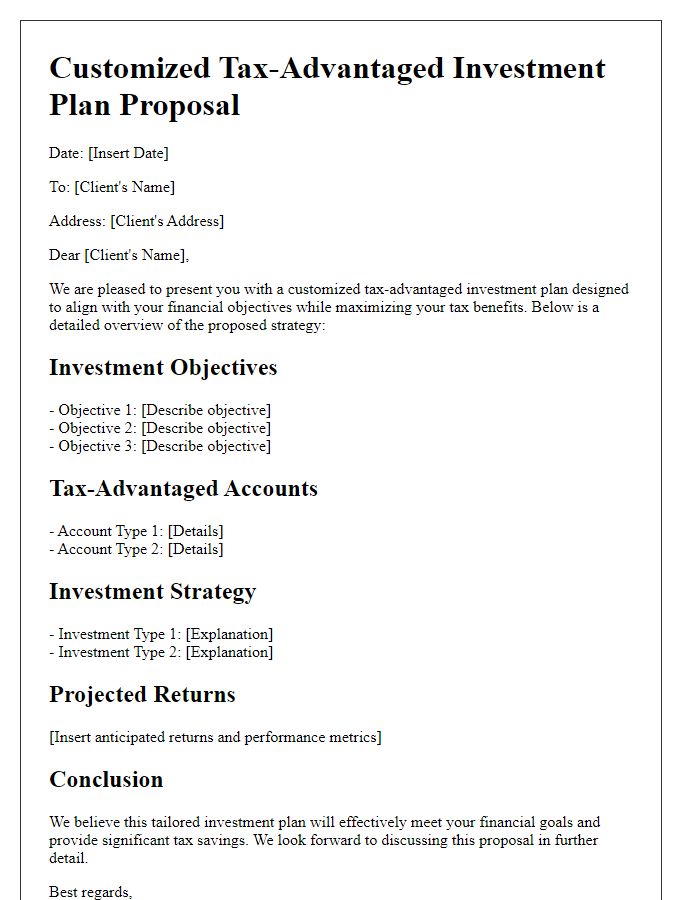Are you looking to maximize your financial growth while minimizing your tax burden? In today's ever-evolving investment landscape, tax-advantaged options present an exciting opportunity for savvy investors. By strategically leveraging these investment vehicles, you can enjoy not only potential returns but also significant tax benefits. Join us as we delve deeper into the world of tax-advantaged investments and explore how they can enhance your financial strategy.

Clear Objective Statement
A tax-advantaged investment proposal focuses on maximizing returns while minimizing tax liabilities through strategic financial planning. The main objective is to identify investment vehicles such as Individual Retirement Accounts (IRAs), Health Savings Accounts (HSAs), or 529 College Savings Plans that offer significant tax benefits. These accounts allow for tax-deferred growth or even tax-free withdrawals under specific conditions, enhancing overall investment performance. Targeted investments may include municipal bonds, which often provide interest income exempt from federal taxes, or real estate investment trusts (REITs) that can generate tax-advantaged income through deductions and depreciation. Effective diversification across these vehicles can lead to a more robust financial portfolio that aligns with long-term goals while navigating the complex tax landscape.
Comprehensive Financial Analysis
A comprehensive financial analysis of tax-advantaged investment options, such as Individual Retirement Accounts (IRAs) and 401(k) plans, highlights potential benefits like tax deferral and growth accumulation. The analysis includes projected returns based on historical market performance, typically around 7-10% annually over long-term investments. It examines the impact of tax brackets, which can change significantly, influencing net gains upon withdrawal during retirement, particularly over 20-30 years. Strategic contributions, adhering to IRS limits of $6,500 for IRAs and $22,500 for 401(k)s as of 2023, are also considered, along with employer matching contributions. This detailed evaluation aids in aligning investment choices with personal financial goals, optimizing long-term growth while minimizing tax liabilities. By leveraging tools like compound interest calculations and diversification strategies across asset classes, investors can enhance financial security in retirement.
Tax Benefits Explanation
Tax-advantaged investment proposals offer various financial incentives that can significantly enhance investment returns while minimizing tax liabilities. Individuals can benefit from tax deductions on contributions, such as those found in Individual Retirement Accounts (IRAs) or 401(k) plans, where contributions may reduce taxable income in the year they are made. Additionally, capital gains tax rates on qualified investments, held for more than one year, are often lower than ordinary income tax rates, encouraging long-term investment strategies. Tax-free growth opportunities are also present in accounts like Health Savings Accounts (HSAs) or 529 college savings plans, which allow for tax-free withdrawals when funds are used for qualified expenses, maximizing potential growth. Understanding these tax benefits helps individuals make informed decisions about their investment strategies, ultimately aiding in wealth accumulation and financial planning.
Risk Assessment and Mitigation
In the realm of financial investments, particularly tax-advantaged strategies such as 401(k) plans or Health Savings Accounts (HSAs), a thorough risk assessment identifies potential pitfalls while ensuring compliance with IRS regulations. Market volatility poses a significant risk, with indices like the S&P 500 exhibiting fluctuations exceeding 15% during economic downturns. Additionally, regulatory changes enacted by government entities can influence tax benefits, impacting overall yield. Mitigation strategies include diversification across various asset classes, such as equities (stocks of companies like Tesla or Apple), bonds (government or municipal), and real estate investment trusts (REITs), which historically provide stability. Incorporating stop-loss orders can further limit exposure to drastic declines, protecting capital invested in high-risk sectors. Regular portfolio reviews are essential, enabling proactive adjustments in response to changing economic landscapes or personal financial situations. Collaboration with financial advisors familiar with tax implications enhances the decision-making process, promoting informed investments that align with individual financial goals.
Call to Action and Contact Information
Tax-advantaged investment opportunities present significant benefits for investors, including increased savings through tax incentives. For instance, options like Individual Retirement Accounts (IRAs), Health Savings Accounts (HSAs), and 401(k) plans provide various tax deductions and deferred tax liabilities. Engaging with a financial advisor can help tailor investment strategies that fit personal financial goals. To take advantage of these opportunities, proactive steps are required, including consultations and timely contributions. Interested individuals should reach out to investment firms or financial planners specializing in tax strategies to determine the best course of action. Contact information typically includes phone numbers, email addresses, and office locations to facilitate easy communication and planning.













Comments